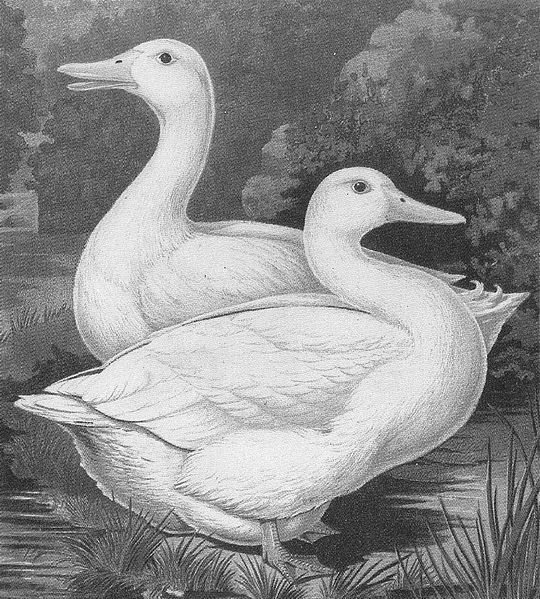Aylesbury

Mary Simmons of Hartwells prize-winning Aylesbury ducks
Aylesbury
The Aylesbury duck breed was developed around the early 18th century and became a cottage industry in Aylesbury in southern England. The ducks were walked South to the markets in London stopping at night at inns which provided large enclosed yards for a few birds. Each morning the feet of the birds were given some protection by driving them across a shallow ditch filled with a cold tarry solution which made their feet sticky, then through sawdust which adhered to their feet. In 1839 the introduction of a railway connection (Cheddington to Aylesbury Line) made transport easier and the trade flourished, but around the middle of the century duck rearing in the town began to decline.
Following the introduction of the Pekin duck in 1873 the two breeds were often crossed, and the pure breed became rarer, but later efforts have been made by breeders to re-establish the Aylesbury Duck. The crossbred commercial meat-type of white duck is the bird most people will see and is the one most mistakenly thought of as an “Aylesbury” because it is white (a true Aylesbury is rare). If the duck has an orange or yellow bill this generally indicates the strain has been bred with the ‘Pekin’ at some stage and is therefore not a pure Aylesbury. The commercial crossbred strain is now farmed all over the world as the quality of meat obtained from the breed is high.
The Aylesbury has white skin and plumage, a pink bill, blue eyes and orange legs. The pink bill and a horizontal carriage (meaning that the keel of the bird should be parallel to and touching the ground when the bird is standing at rest) are key characteristics of the true Aylesbury breed. Their feathers are also used for quilt fillings.
Classification
Heavy
Appearance
White
Weight
| Drake | 4.5 – 5.4 Kg |
| Duck | 4.1 – 5.0 Kg |
Egg Colour
White


